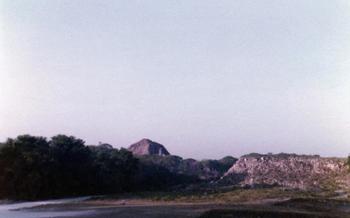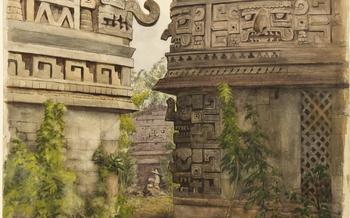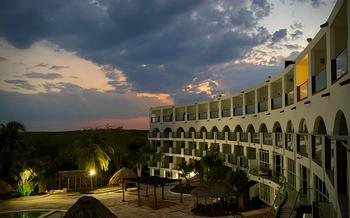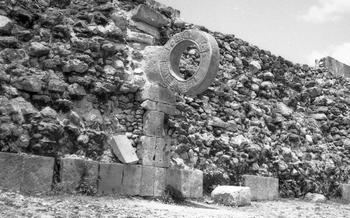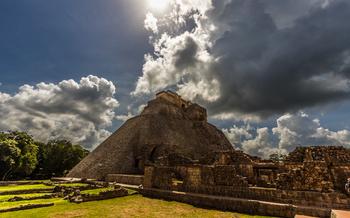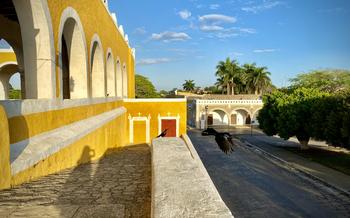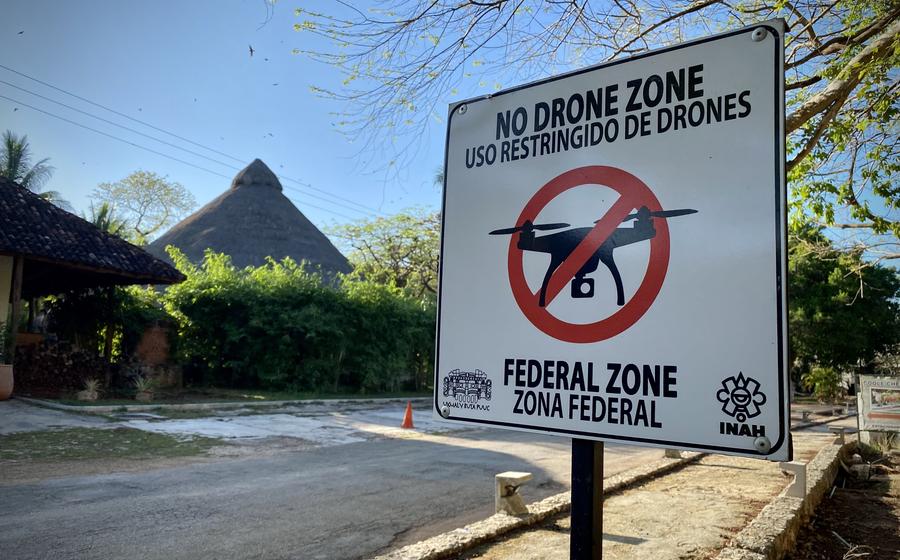
Labna Archaeological Site
- Exploring the Enchanted World of Labna
- Labna's Architectural Masterpieces: The Arch of Labna and El Palacio
- Unveiling the History of Labna: A Thriving Mayan City
- The Miraculous Cenote of Labna: A Sacred Water Source
- Exploring the Residential Areas of Labna: A Glimpse into Daily Mayan Life
- Unraveling the Mysteries of the Stelae and Altars
- The Ballcourt at Labna: A Stage for Ancient Mayan Rituals
- Discovering the Hidden Treasures of the Museum at Labna
- Tips for a Memorable Visit: Planning and Preparation
- Photography Enthusiasts' Delight: Capturing Labna's Beauty
- Off-the-Beaten-Path Gems: Exploring Beyond the Main Ruins
- Stepping Back in Time: Historical Reenactments and Cultural Performances
- Local Cuisine and Culinary Delights: A Taste of Yucatecan Flavors
- Insider Tip: Unveiling the Secrets of the Night Sky
Exploring the Enchanted World of Labna
Prepare to be captivated by the enchanting allure of Labna, an ancient Mayan city nestled within the Yucatan Peninsula, a mere 25 kilometers southwest of the iconic Uxmal. As you venture into Labna, immerse yourself in the mystical aura that permeates the air, transporting you back in time to a world where the Maya civilization thrived.
This archaeological site, though smaller in size compared to its renowned neighbor, holds its own unique charm and significance. Step into a realm where history and nature intertwine, where majestic structures stand amidst lush vegetation, creating a harmonious tapestry of architectural wonders and natural beauty.
Labna, once a thriving urban center, played a crucial role in the political and economic dynamics of the ancient Maya world. Its strategic location along trade routes allowed for the exchange of goods and ideas, contributing to the city's prosperity and cultural development. Discover the fascinating story of Labna as you explore its remnants, each stone whispering tales of a civilization that once flourished in this enchanting land.
Labna's Architectural Masterpieces: The Arch of Labna and El Palacio
Among the many architectural wonders of Labna, the Arch of Labna and El Palacio stand out as remarkable testaments to the ingenuity and artistry of the ancient Maya. The iconic Arch of Labna, also known as the Arco Triunfal, is a stunning gateway that symbolizes the grandeur and power of the ancient city. Constructed using the corbel arch technique, the arch features intricate carvings depicting various deities, rulers, and mythical creatures. Its intricate details and symbolic significance make it a true masterpiece of Mayan architecture.
El Palacio, on the other hand, is the largest and most impressive structure within the site. This majestic palace served as the administrative and residential center of Labna's rulers. Its imposing facade, adorned with elaborate carvings and sculptures, showcases the exceptional craftsmanship of the Maya. The interior of El Palacio reveals a series of interconnected rooms and courtyards, each with its own unique features and purposes. Exploring this grand structure provides a glimpse into the opulent lifestyle of the Mayan elite and offers a deeper understanding of the city's political and social organization.
Unveiling the History of Labna: A Thriving Mayan City
Labna, like many other ancient Mayan cities, experienced a dynamic and complex history, marked by periods of prosperity, decline, and transformation. The city's origins can be traced back to the Late Classic period (600-900 AD), during which it emerged as a significant regional center. During this time, Labna's rulers oversaw the construction of impressive architectural complexes, including the iconic Arch of Labna and El Palacio. The city also played a crucial role in trade and commerce, connecting the Puuc region with other Mayan centers in the Yucatan Peninsula.
However, around the 10th century AD, Labna began to decline, coinciding with the broader collapse of the Classic Maya civilization. The reasons for this decline are still debated, but factors such as environmental changes, political instability, and warfare may have played a role. As a result, Labna's population dwindled, and the city was eventually abandoned by its inhabitants.
Despite its decline, Labna's legacy continued to influence the Maya civilization. The architectural innovations and artistic traditions developed in Labna were adopted and adapted by other Mayan cities, contributing to the cultural and artistic richness of the Maya world. Furthermore, the city's strategic location and its role in trade and commerce ensured that its influence extended beyond its immediate boundaries, shaping the development of the broader Puuc region.
The Miraculous Cenote of Labna: A Sacred Water Source
Within the confines of the Labna archaeological site lies a natural wonder of immense significance to the ancient Maya: the Miraculous Cenote. This subterranean marvel, with its crystal-clear waters and otherworldly ambiance, served as a sacred water source for the Maya and played a vital role in their daily lives and spiritual practices.
The cenote, located in the heart of the site, was not merely a source of drinking water but held profound religious and symbolic meanings. The Maya believed that cenotes were gateways to the underworld, Xibalba, and revered them as sacred portals connecting the physical and spiritual realms. Rituals and ceremonies were often conducted at the cenote, with offerings made to the gods in exchange for blessings and protection.
Legends and myths abound regarding the Miraculous Cenote. One tale speaks of a beautiful maiden who was sacrificed to the rain god Chaac to end a severe drought. Her spirit is said to reside in the cenote, ensuring a steady flow of water for the community. Another legend tells of a hidden treasure buried beneath the cenote's depths, guarded by spirits who only reveal it to those with pure hearts.
Today, visitors can still marvel at the beauty and mystery of the Miraculous Cenote. Descending into its depths, one is transported to a realm of tranquility and awe. The crystal-clear waters reflect the surrounding vegetation, creating a kaleidoscope of colors and light. The air is filled with the sound of dripping water and the gentle chirping of birds, creating a serene and meditative atmosphere.
For the Maya, the Miraculous Cenote was more than just a water source; it was a sacred place of reverence and a symbol of their deep connection to the natural world. Its presence within the Labna archaeological site serves as a reminder of the rich spiritual and cultural heritage of this ancient civilization.
Exploring the Residential Areas of Labna: A Glimpse into Daily Mayan Life
Venturing beyond the ceremonial center of Labna, visitors can explore the intriguing residential areas that provide a glimpse into the daily lives of the ancient Maya. These compounds, typically arranged around courtyards, consisted of several structures serving various purposes. The houses, built with sturdy stone walls and thatched roofs, showcased unique architectural features and intricate designs.
Inside these residences, archaeologists have uncovered evidence of the Maya's domestic life. Grinding stones for preparing food, ceramic vessels for storage and cooking, and remnants of hearths suggest the practical aspects of daily life. Personal items such as jewelry, tools, and pottery provide insights into their customs and artistic expressions.
The layout of the residential areas reveals the social structure of Labna. Larger compounds with multiple rooms and elaborate decorations likely belonged to the city's elite, while smaller, simpler structures housed the commoners. This spatial organization reflects the hierarchical nature of Mayan society.
Exploring the residential areas of Labna is a journey through time, allowing visitors to connect with the ancient Maya on a personal level and gain a deeper understanding of their daily lives, customs, and social interactions.
Unraveling the Mysteries of the Stelae and Altars
Scattered throughout the ancient city of Labna, stelae and altars stand as silent witnesses to the religious beliefs and practices of the Maya. These intricately carved stone monuments offer a glimpse into the spiritual world of this enigmatic civilization.
Stelae, tall, upright stones, often depict Mayan rulers, deities, or important events. Their surfaces are adorned with elaborate carvings that narrate historical events, commemorate important figures, or convey religious messages. The glyphs and symbols etched into the stelae provide valuable insights into Mayan writing, calendrics, and mythology.
Altars, on the other hand, served as sacred platforms for offerings and rituals. Often placed in temples or near significant structures, these altars were used for ceremonies, prayers, and sacrifices. The carvings on the altars often depict religious symbols, deities, or scenes of ritual practices, offering clues to the spiritual beliefs and practices of the ancient Maya.
Examining the stelae and altars at Labna is like stepping into a time capsule, allowing visitors to connect with the minds and hearts of the ancient Maya. Each monument tells a story, revealing the beliefs, rituals, and ceremonies that shaped the lives of this remarkable civilization.
The Ballcourt at Labna: A Stage for Ancient Mayan Rituals
Amidst the sprawling ruins of Labna, the ballcourt stands as a testament to the significance of the ancient Mayan ballgame. Located on the site's western side, this impressive structure showcases the Maya's architectural prowess and deep-rooted cultural traditions. Measuring approximately 85 meters in length and 30 meters in width, the ballcourt features two parallel, sloped walls with stone rings embedded at strategic points. These rings, known as marcadores, served as goals through which the heavy rubber ball had to be passed.
The Mayan ballgame, known as pok-ta-pok, was more than just a sport; it held profound ritual and symbolic meaning. It was believed to represent the cosmic struggle between opposing forces, mirroring the cyclical nature of life and death. The ball, symbolizing the sun, was propelled back and forth, mimicking its journey across the sky. The outcome of the game held great significance, often determining the fate of political alliances or predicting the success of agricultural harvests.
Beyond its ritualistic significance, the ballcourt also served as a social and entertainment hub for the community. Spectators from all walks of life gathered to witness the thrilling matches, which were accompanied by music, dance, and lively chants. The ballcourt provided a venue for social interaction, cultural exchange, and the fostering of community spirit.
Discovering the Hidden Treasures of the Museum at Labna
Enrich your understanding of Labna's history and culture by visiting the on-site museum, a treasure trove of Mayan artifacts and insights. Admire the intricate pottery, finely carved sculptures, and ceremonial objects that tell the story of this ancient city. Learn about the research and conservation efforts undertaken to preserve these precious relics, ensuring their legacy for generations to come. The museum serves as a window into the rich cultural heritage of the Maya, allowing you to delve deeper into their beliefs, traditions, and artistic expressions.
Tips for a Memorable Visit: Planning and Preparation
To make the most of your visit to Labna, careful planning and preparation are key. Before embarking on your journey, consider these practical tips for a smooth and enjoyable experience:
-
Advance Planning: Research the site's hours of operation, entrance fees, and any special events or exhibitions that may coincide with your visit. Purchase tickets online or at the site's entrance to avoid queues, especially during peak season. Arrange transportation to and from the site, whether by rental car, tour group, or local transportation. Pack essentials like comfortable clothing, sturdy footwear, sun protection, and a refillable water bottle.
-
Appropriate Attire and Footwear: Dress comfortably and in layers as the weather can be unpredictable. Wear light-colored, loose-fitting clothing to stay cool in the tropical heat. Closed-toe shoes or hiking boots are recommended for navigating uneven terrain and protecting your feet from sharp stones or roots.
-
Sun Protection and Hydration: The Yucatán sun can be intense, so apply sunscreen regularly and wear a hat and sunglasses to shield your eyes and skin. Carry a refillable water bottle to stay hydrated throughout your visit, especially if exploring the site during the warmer months.
Photography Enthusiasts' Delight: Capturing Labna's Beauty
Labna's ancient ruins offer a treasure trove of photographic opportunities for enthusiasts of all levels. The best time to capture the site's beauty is during the golden hours of sunrise and sunset, when the warm light casts a magical glow on the stone structures. Experiment with different angles and perspectives to showcase the intricate details of the carvings and the grandeur of the architecture. Use a tripod to ensure sharp images, especially when shooting in low-light conditions. For close-up shots, focus on the unique features and textures of the ruins, such as the intricate carvings on the arch or the weathered surfaces of the buildings. Don't forget to capture the surrounding landscape, including the lush vegetation and the vast expanse of the Yucatan sky.
Off-the-Beaten-Path Gems: Exploring Beyond the Main Ruins
While the main ruins of Labna are undoubtedly captivating, venturing beyond these popular areas offers a unique opportunity to discover hidden treasures that often go unnoticed by many visitors. Explore lesser-known structures, such as the smaller temples, residential compounds, and agricultural terraces, to gain a deeper understanding of the daily life and customs of the ancient Maya.
Immerse yourself in the surrounding natural landscapes, where you can spot diverse flora and fauna. Observe the intricate root systems of towering trees that have entwined themselves with ancient ruins, creating a harmonious blend of nature and history. Keep an eye out for wildlife, including iguanas, birds, and even monkeys, that call this area home.
The tranquility and serenity of the less-frequented areas of Labna provide a peaceful respite from the crowds. Find a secluded spot to sit and contemplate the beauty of your surroundings, allowing the ancient energy of the site to wash over you. Let your imagination run wild as you envision the lives of the Maya who once called this place home.
Stepping Back in Time: Historical Reenactments and Cultural Performances
Labna offers a unique opportunity to experience the rich cultural heritage of the ancient Maya through historical reenactments and cultural performances. These captivating events transport visitors back in time, providing a glimpse into the vibrant world of Mayan traditions and customs.
Traditional Mayan dances, accompanied by rhythmic music and colorful costumes, showcase the grace and artistry of this ancient culture. Visitors can witness the intricate steps and graceful movements that tell stories of love, war, and the divine. These performances not only entertain but also offer a deep appreciation for the cultural diversity of the Maya.
Beyond dance, Labna hosts cultural performances that highlight the skills and artistry of local artisans. Visitors can interact with these talented individuals, learning about their techniques and the significance of their crafts. From intricate weaving and pottery to traditional woodcarving, these artisans showcase the enduring legacy of Mayan craftsmanship.
These historical reenactments and cultural performances provide an immersive experience that brings Mayan history and culture to life. They offer visitors a deeper understanding of the ancient Maya and their enduring influence on the region.
Local Cuisine and Culinary Delights: A Taste of Yucatecan Flavors
No visit to Labna is complete without savoring the delectable flavors of Yucatecan cuisine. This region of Mexico boasts a rich culinary tradition that blends Mayan and Spanish influences, resulting in a unique and tantalizing array of dishes.
To truly immerse yourself in the local culture, venture beyond the tourist traps and seek out authentic restaurants or street food stalls. Here, you can indulge in regional specialties such as cochinita pibil, a slow-roasted pork dish marinated in achiote paste and wrapped in banana leaves. Another must-try is panuchos, thick tortillas topped with refried beans, shredded turkey or chicken, and a tangy tomato sauce.
For a refreshing treat, try marquesitas, crispy crepes filled with Edam cheese and your choice of sweet or savory fillings. And don't forget to sample the local fruit, which is bursting with flavor and sweetness.
Yucatecan cuisine is not for the faint of heart, as it often features bold flavors and generous use of spices. However, for those willing to embrace the heat, the rewards are immense. So, be sure to come hungry and ready to experience a culinary adventure that will tantalize your taste buds and leave you craving more.
Insider Tip: Unveiling the Secrets of the Night Sky
As darkness envelops Labna, a celestial spectacle unfolds above, revealing the secrets of the night sky. Far from the intrusive glow of city lights, the stars shine with unparalleled brilliance, casting an ethereal glow upon the ancient ruins. This is a place where the Maya once gazed upon the cosmos, attributing deep significance to the movements of the stars and planets.
Join a guided night tour to unravel the mysteries of Mayan astronomy. Learn about their intricate calendar system, which tracked the cycles of the sun, moon, and Venus, and played a vital role in their agricultural and religious practices. As you stand beneath the vast expanse of the night sky, feel a profound connection to the ancient Maya and their reverence for the cosmos.
Whether you're an avid stargazer or simply seeking a unique and awe-inspiring experience, Labna's night sky is sure to leave you spellbound. Allow yourself to be captivated by the celestial wonders above, creating a truly unforgettable travel memory that will last a lifetime.

